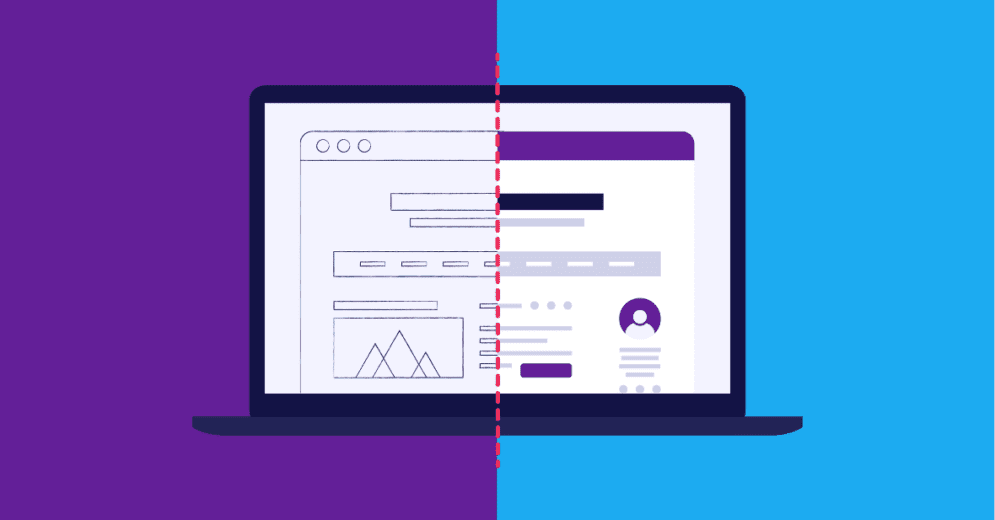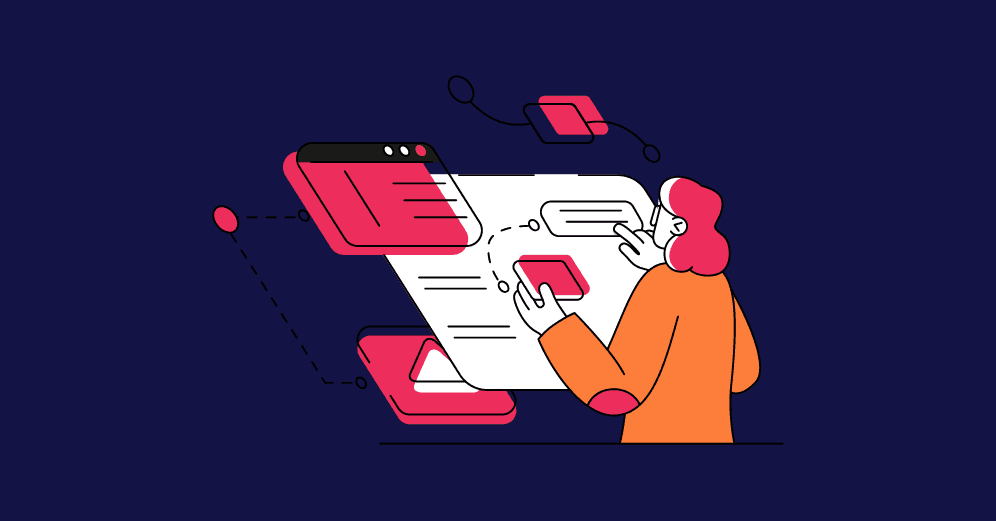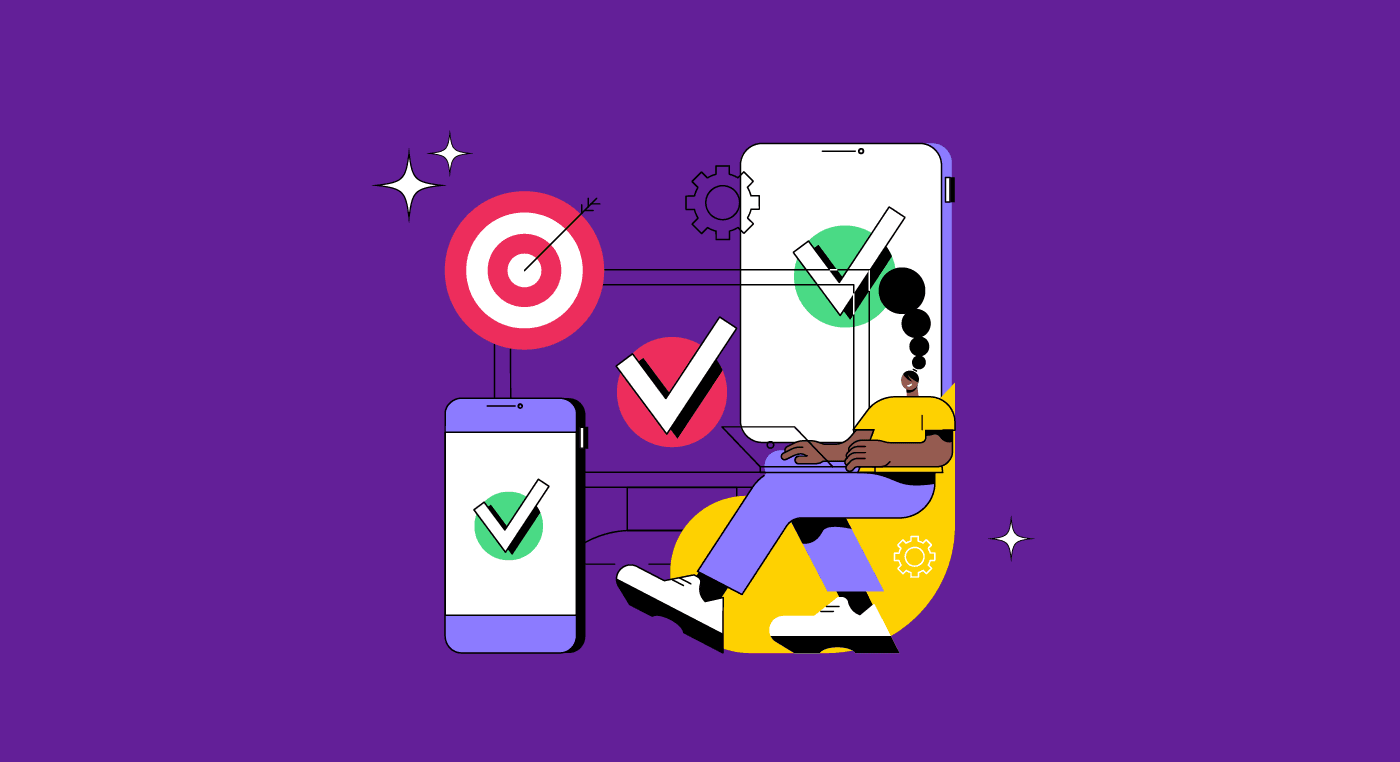One of the main challenges for those interested in UX and UI Design is understanding the terms used in the field. This happens because, in user experience, many concepts relate to each other.
In addition, the field is relatively new, it keeps growing, and with technology advancing every day, the expertise sub-fields also evolve with it. So, of course, the professions related to UX and their roles and responsibilities can cause a lot of confusion to the public.
So we will help clarify the most common doubts about UX and UI design, the differences between these areas, how professionals work, and what companies are looking for!
What is UX Design?

UX stands for user experience. Simply put, UX means the relationship between a customer and a given product or service.
User experience design is responsible for planning and organizing how something looks and works to make the activity of using it easy and enjoyable for the users.
There are a couple of essential objectives of UX design:
- It must meet user needs;
- The product or service should be easy to use and easy to learn;
- It must provide users control and freedom;
- To make a difference, it should also surprise and delight.
Thus, the role of the UX Designer is to make the interaction between products and users happen as smoothly as possible while providing the customer with a great experience.
We have seen design grow from a trade activity to a segment profession to a field for technical research and to what now should be recognised as a new liberal art of technological culture. Richard Buchanan
What happens when there’s no one responsible for the UX?

A Norman door is a poorly designed door that confuses or fails to give us a clear idea of whether to push or pull. The concept was named after cognitive scientist Don Norman, author of The Design of Everyday Things.
Of course, the door is just an example of how a bad design can complicate our lives and provide us with a bad experience. These issues can also be found in other objects, like switches or faucets, which often make us dance around the room to find out how to make such a simple thing work.
So, when there is no one thinking about the user experience of a product, it is common to find the following situations:
- a user struggling to understand how an app or software works;
- users can’t complete their tasks; like an e-commerce check-out process, for example;
- consumers can’t change specific settings of their account or quickly navigate through a website, app, or software.
Therefore, UX Design is the combination of empathy, usability, technology, and a human touch during the development of a product.
The role of UX Designers
The primary responsibility of a UX designer is the overall user satisfaction with a product or service. UX designers are continuously testing their products and gathering user feedback to improve the user experience for users—the improvements or additions will vary according to user feedback.
Furthermore, UX designers advocate for their customers while not losing sight of the company’s objectives. They ensure that users can easily find the content of a product and that multi-step processes are clear and intuitive for them.
- Deep understanding of users and their needs;
- Conduct usability tests and apply the necessary changes;
- Develop interactions that can help users achieve their goals;
- Contribute with solutions to improve overall user experience;
- Collaborate with business goals.
However, apart from benefiting the user, UX Design also contributes to the evolution of the brand and the company.
In this sense, companies that place the user at the center of their design decisions can benefit from:
- Brand loyalty;
- Increase in profitability;
- Improve company image.
UX design tasks and deliverables
UX designers worry about the entire experience people have with products or services. For that, there’s a ton of research and activities they must carry out, such as:
- Research to find out who the users of a product are;
- Creating personas to assist in the project’s development;
- Research user needs, pains, motivations, and goals;
- Interviews with stakeholders to better understand the company’s goals;
- Interviews with users;
- Elaborate storyboards to help illustrate users’ actions and their context;
- Usability tests to gather feedback;
- A/B tests to evaluate different options;
- Conducting heuristic analysis to identify usage difficulties and replace them with more assertive solutions;
- Elaborating user journey and identifying opportunities for improvement.
- Building prototypes.
Apart from the tasks listed above, there are a few essential UX deliverables that are possible from the efforts of the activities mentioned:
- Site maps;
- UX wireframes;
- Design systems;
- Low-fidelity, high-fidelity, or interactive prototypes;
- Experience Maps and User Flows.
- Usability reports;
- Analytics report.
Where can UX Designers work?
The job opportunities for UX professionals are vast, as customer experiences are present in every company. The most common scenarios, however, are the following:
- Companies that deal with digital products, such as software, apps, or websites;
- Within agencies that work with digital products;
- Government agencies that provide vital information and services that affect people’s daily lives;
- As a freelancer working for various companies;
- Remotely for national or international companies.
In short, the UX area is responsible for conducting in-depth research and usability tests to understand more about users, their habits, and their needs.
What is UI Design?

UI stands for User Interface, which typically refers to graphical user interfaces. Through a User interface, people can access and interact with designs.
Thus, the UI Designer focuses mainly on how the interaction looks, that is, the visual aspect of a digital product and how aesthetically pleasing the interface is—or how it feels, in the case of virtual assistants.
The interface can come in three formats:
- Graphical user interfaces: users interact with visual representations on digital control panels. A computer’s desktop is a GUI.
- Voice-controlled interfaces: the interaction happens through the user’s voice. Most smart assistants like Siri or Alexa are VUIs.
- Gesture-based interfaces: users engage with design spaces in 3D, through bodily motions, like in virtual reality games.
The role of UI Designers
UI design covers all aspects of visual and interactive elements of digital products, working with typography, color palettes, animations, and navigational touchpoints like buttons and scrollbars.
Since UI design is a craft where designers build the aesthetic part of the overall user experience, designers relocating to UI will work together with UX designers.
Hence, they can work in the same places and with the same flexibility as the ones mentioned above.
But, of course, not every company has reached UX maturity, and it’s very common to see designers doing both jobs because UX and UI design can and often do overlap.
And that’s why it’s very natural to see companies and organizations combine these roles into one position and why many people use the terms UX/UI interchangeably.
Consequently, designers often seek to enhance and expand their skills in the expertise they are not so fluent in.
While employers shouldn’t expect these professionals to master both UX and UI design skills, one thing is sure: having a good knowledge of both specializations can usually grant designers an employable edge.
However, as more companies expand their design maturity levels, this will hopefully no longer be true.
Furthermore, UI Designers work a lot with prototyping. That is, they create low and high-fidelity versions to validate concepts and perform usability tests of the interface with users.
UI Design tasks and deliverables
By now, you might be starting to grasp how UI design is embedded in UX. Many of the deliverables listed before in the scope of UX design are also part of UI design, like design systems, wireframes, and prototypes.
Ultimately, UI designers will visually represent the concepts and ideas that were pre-defined by UX designers. To summarize, their roles will overlap whenever there is a connection between the concept and the visual work.
For example, a UI designer might have to work on a conceptual wireframe before jumping to the visuals. In contrast, UX designers might have to work further on their concepts and wireframes, creating a more finished visual state.
Below are some of the activities expected from a UI Designer:
- Information architecture;
- Designing the screens that users will interact with;
- Creating responsive designs, that is, considering how the app will display on various devices and screen sizes;
- Designing UI elements such as buttons, icons, sliders, and scrollbars;
- Choosing the appropriate typography and color pallet;
- Designing the interactivity of each UI element, like what a button do when the user clicks on it;
- Creating animations;
- Establishing a style guide with all the UI elements.
Furthermore, UX and UI designers should work collaboratively to ensure that their both on the same page and towards the same goals while addressing key pain points in the user journey. The style guide, for example, can be a great tool to assist in this cooperation.
What are the differences between UI and UX Design?

To put it simply, while UX designers worry about making the interaction as useful and easy as possible, UI designers work hard on making them look beautiful.
Although the two areas make up the product development process, they differ markedly.
We have listed some of the main differences between the two so that you can quickly familiarize yourself with each one.
1) Macrointeractions vs. Microinteractions

As we said before, UI design is responsible for animations, which are a form of micro-interactions.
Microinteractions are responses from user actions that appear in the user interface or that happen in the system (in the case of virtual assistants). The trigger can be a user action, with the feedback visually appearing in the GUI, or an alteration of the system state.
And as for UX designers, we can see them as architects of macro interactions. The visual elements and any animation to display system status, help prevent errors and engage with users are only possible after the user experience has been established. It’s the final touch, let’s say. And, of course, it makes the whole difference and helps engage with users.
Again, we would like to iterate how common it is to find UX professionals with a strong focus on UI or Interaction Design. In this sense, it is often complex to separate where one begins and the other ends.
2) UX creates useful products. UI makes them enjoyable
UX Designers are responsible for conducting research and competitive analysis, developing personas, applying tests, and creating valuable, useful products that solve user problems.
On the other hand, UI Designers are responsible for translating these requirements into accessible, intuitive, and aesthetically pleasing interactions.
The UI Designer implements a visual hierarchy (and micro-interactions) that helps to guide users through their tasks and navigation.
Reading tip: Visual Hierarchy: How To Prioritize and Highlight Information
3) UX helps users while UI creates emotional connections

People may be attracted to a particular website or app because of the tasks they can accomplish there (UX).
However, they will only keep using it if the visuals are pleasant and the interactions informative and helpful (UI), so they can genuinely engage with the product.
So, UX comes before UI?
Generally, UX Design and Research are the first steps of a project.
This way, the UX Designer handles much of the research that will validate or invalidate a product/service development.
However, this is not a linear process. Even though there are two different professionals or one person doing the whole process, everything is part of the UX Design. Validations, tests, and new hypotheses arise throughout the project.
UX and UI go hand in hand and are reviewed all the time, iteratively. In addition, in companies that use the Agile philosophy, tasks interconnect according to the sprint and not necessarily in sequence
4) UX is employed in products and services, while UI is used mostly in GUIs
UX Design is a vast and growing area. Many companies that don’t have a strong digital presence are starting to get familiar with UX, the value of knowing more about their users, and in which context they will be using a particular product or service.
UI Design, on the other hand, is more focused on interfaces. However, it is not limited to graphical interfaces for computers and mobile devices. Nowadays, we are seeing more and more interfaces in other products, such as watches, washing machines, car dashboards, vending machines, and many others.
What are recruiters looking for?

Companies and organizations tend to prefer professionals who cover both UX and UI design specialties. In this sense, the market seeks designers who can think of the entire experience while providing the looks and the necessary interactions.
In other words, they look for a professional who can contribute to all stages, from the research phases to the final UI delivery.
Also, provide a portfolio that includes a few samples showing your design process, explaining why you have made the decisions that led to those results, and not just a presentation of the final product.
Apart from that, important soft skills like strong communication, leadership, and presentation are vital differentiators for any candidate.
It’s very important to highlight if you have assisted in or run user testing sessions, user interviews, facilitated workshops or presented work to senior stakeholders. Also, if you have mentored others, don’t forget to mention these experiences.








